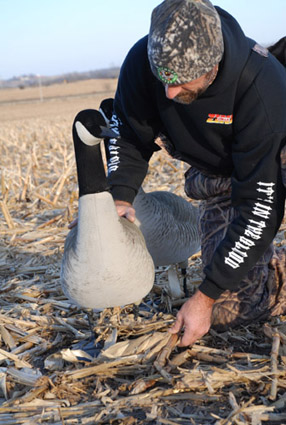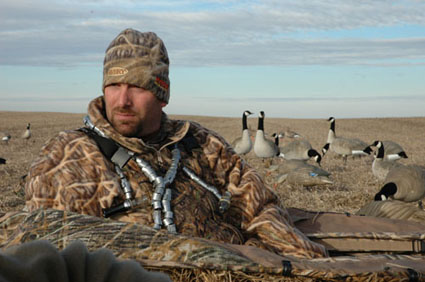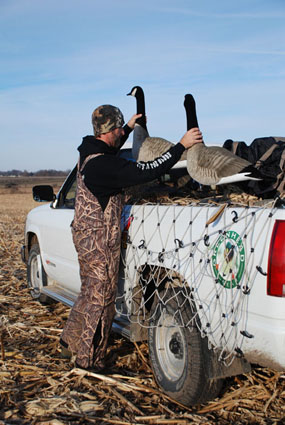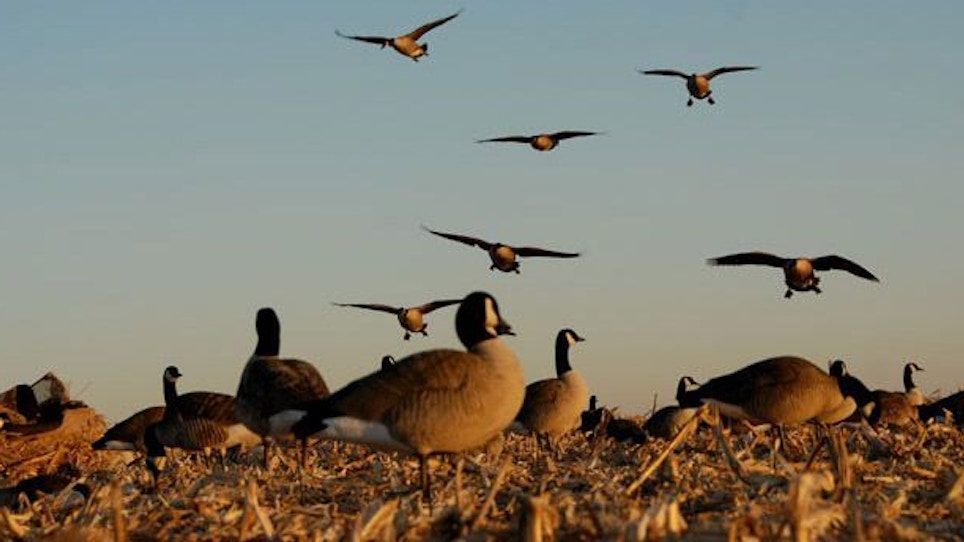 I hate to sound like I’m whining, but I was at my wit’s end. A thousand geese, I told my wife, and I couldn’t do a damn thing with them. “They’re going from the pond at the intersection,” I complained, “to several different development ponds where we can’t get to them. And the ones that are feeding locally are hitting the field adjacent to the roost — again, where we can’t get to them. Hell,” I continued, “these birds aren’t even landing with other live geese. How we gonna kill ’em when they won’t decoy to their own kind!?” She just smiled, God love her, and said exactly what I thought she’d say — “You’ll think of something.”
I hate to sound like I’m whining, but I was at my wit’s end. A thousand geese, I told my wife, and I couldn’t do a damn thing with them. “They’re going from the pond at the intersection,” I complained, “to several different development ponds where we can’t get to them. And the ones that are feeding locally are hitting the field adjacent to the roost — again, where we can’t get to them. Hell,” I continued, “these birds aren’t even landing with other live geese. How we gonna kill ’em when they won’t decoy to their own kind!?” She just smiled, God love her, and said exactly what I thought she’d say — “You’ll think of something.”
So, what do you do when things get tough, and the candy birds — those drop-legged gimmes that could be called with a clarinet and flagged with a Spongebob Squarepants bedspread — have either earned their diplomas, or more likely, ended up the guest of honor on some dining room table? By the calendar, here’s what some of the best in the business have to say about getting the drop on Canadas, when all else fails.
Out Of The Gate – September Canadas
“The biggest misconception people have about hunting early Canada geese is they’re gonna be real easy. More people are doing this early season. The birds are wising up faster. It only takes a couple days for that old gander to get smart or smarter,” says Scott Threinen. A champion goose caller, Threinen grew up hunting some of the most unhuntable Canadas in the country — the birds around his home near Rochester, Minn.
So how, then, do you deal with tough early-season geese? Threinen looks at four variables — scouting, decoys, blinds and calling — and how he can twist each of those factors to best match what’s happening in the field.
“I look at six things when I’m doing my early-season scouting,” says Thrienen. “First, where are the birds roosting. Second, the fields they’re using. Third is something I call their day beds — where are the birds sitting or loafing during the day. Fourth, the fly routes or flight lines. These are very important. Here,” he continues, “you’re looking not only at the routes the birds are taking, but how they’re flying — Are they flying low? High? Cruising? Five is the birds’ behavior on the ground. Are they lounging around in the field? Are they feeding? Or are they simply using the field for take-off and landing practice, which the adults will do with their young-of-the-year birds? And six,” he closes, “is the weather, as the weather is going to dictate what, if anything, these birds are going to do on any given day.”
 Armed with this type of detailed information, Thrienen then turns his attention to decoys. “During the early season,” he says, “I usually set six decoys, and typically never more than 24, but I will change as the birds themselves change.”
Armed with this type of detailed information, Thrienen then turns his attention to decoys. “During the early season,” he says, “I usually set six decoys, and typically never more than 24, but I will change as the birds themselves change.”
Despite what some might think, competitive goose callers like Thrienen don’t do a lot of calling in the field; in fact, most are surprisingly conservative. “I like a call with a lot of volume,” he says. “I like to set up on the edge of the flight line or fly route, not directly underneath, and call them to me. That’s why I like a high-volume call. Something where they’re going to hear you. On windy days, I call a little more. On rainy days when they’re flying low and quiet, I do less calling.”
Mid-Season Or Transitional Geese
“Guys aren’t being mobile now in this mid-season. They’re not changing. They’re not being adaptable,” says Michigan goose hunter George Lynch, owner of Lynch Mob goose calls. “Guys think ’cause they’re seeing the birds, they’re going to be shooting the birds. They’re underestimating the birds. You’ve got to change it up.”
Mid-season birds, Lynch explains, can be some of the most difficult birds of the season. “Now you’re getting a few flight birds every two to three days with a good north/northwest wind,” Lynch says, “but you haven’t gotten the bulk of your new flight birds yet. You need those north winds, or else you’re hunting the same birds that have been banged around since early September — and those can be extremely tough.”
What makes the situation even tougher, Lynch explains, is that everybody wants to hunt the birds the same way. So how does he address this “being different” issue? “I look around,” he says, “and I take note of what the other guys are using. And then I’ll use something different. I’ll emphasize movement in my spread. I like windsocks. Guys keep forgetting about the basics, like windsocks. We think we have to be high-tech.”
 Birds At The Final Bell
Birds At The Final Bell
“Any bird that’s been through that gauntlet — come into a decoy spread and seen the guns going off and see birds fall — they start getting smart quick. And they don’t have to have it happen 10 or 12 times,” says Ron Latschaw. As hardcore a goose hunter as there is, Latschaw of southern Oregon is best known as the creator of the Eliminator series of low-profile layout blinds.
As Thrienen does in September, Latschaw concentrates on scouting, decoys and calling once mid-season gives way to December and January.
“The biggest thing now,” says Latschaw, “is that I’m really cautious in the way I approach fields. I never drive out into the fields — never. I stay completely away, and do all my looking with binoculars, if I can. Those late-season birds are spooky.”
Similarly, his decoy spreads change once the birds have proved they’ve earned their doctorate degrees.
“I put out eight decoys,” says Latschaw. “That’s kind of my magic number. A lot of people think I’m lying when I say it, but I’ve had some of the best shoots over just eight decoys. One reason is that when geese commit and come into a spread of eight decoys, they’re right there. There’s no getting away from you.”
In keeping with his small decoy spread, Latschaw also tones down his calling during this late-season, particularly when he knows he’s working with educated birds.
“I back way off on everything, and get real subtle,” says Latschaw. “If they’re coming, I let ’em come. Maybe a confidence double cluck, or a moan just to keep ’em coming. But I never, never try to overdo it ’cause you’ll blow ’em out.”
Intensive scouting, small decoy spreads, subtle calling, and the willingness to adapt when others aren’t. These, not high-tech futuristic gadgets or logistically impossible plots, are the tactics that are putting hard-to-hunt geese on the ground for gunners coast to coast; gunners, that is, who are willing to step back to the pseudo-basics in order to jump light-years ahead of geese — when all else fails.






